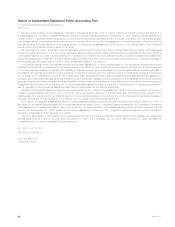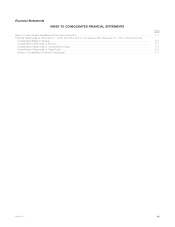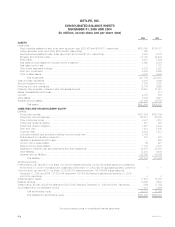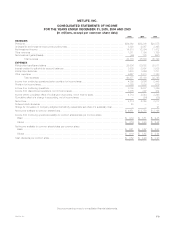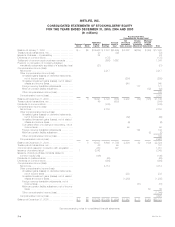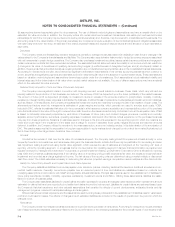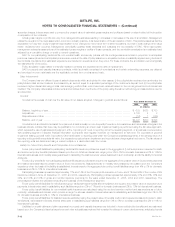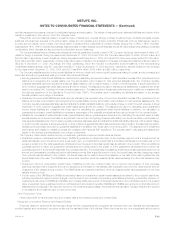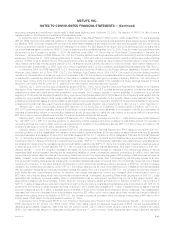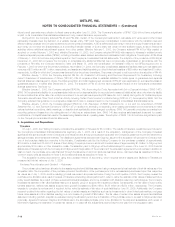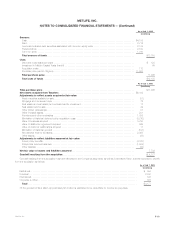MetLife 2005 Annual Report Download - page 71
Download and view the complete annual report
Please find page 71 of the 2005 MetLife annual report below. You can navigate through the pages in the report by either clicking on the pages listed below, or by using the keyword search tool below to find specific information within the annual report.METLIFE, INC.
NOTES TO CONSOLIDATED FINANCIAL STATEMENTS — (Continued)
risks. The Company periodically reviews actual and anticipated experience compared to the aforementioned assumptions used to establish assets and
liabilities relating to ceded and assumed reinsurance and evaluates the financial strength of counterparties to its reinsurance agreements using criteria
similar to that evaluated in the security impairment process discussed previously. Additionally, for each of its reinsurance contracts, the Company must
determine if the contract provides indemnification against loss or liability relating to insurance risk, in accordance with applicable accounting standards.
The Company must review all contractual features, particularly those that may limit the amount of insurance risk to which the reinsurer is subject or
features that delay the timely reimbursement of claims. If the Company determines that a reinsurance contract does not expose the reinsurer to a
reasonable possibility of a significant loss from insurance risk, the Company records the contract using the deposit method of accounting.
Litigation
The Company is a party to a number of legal actions and regulatory investigations. Given the inherent unpredictability of these matters, it is difficult to
estimate the impact on the Company’s consolidated financial position. Liabilities are established when it is probable that a loss has been incurred and the
amount of the loss can be reasonably estimated. Liabilities related to certain lawsuits, including the Company’s asbestos-related liability, are especially
difficult to estimate due to the limitation of available data and uncertainty regarding numerous variables used to determine amounts recorded. The data
and variables that impact the assumptions used to estimate the Company’s asbestos-related liability include the number of future claims, the cost to
resolve claims, the disease mix and severity of disease, the jurisdiction of claims filed, tort reform efforts and the impact of any possible future adverse
verdicts and their amounts. On a quarterly and annual basis, the Company reviews relevant information with respect to liabilities for litigation, regulatory
investigations and litigation-related contingencies to be reflected in the Company’s consolidated financial statements. The review includes senior legal
and financial personnel. It is possible that an adverse outcome in certain of the Company’s litigation and regulatory investigations, including asbestos-
related cases, or the use of different assumptions in the determination of amounts recorded could have a material effect upon the Company’s
consolidated net income or cash flows in particular quarterly or annual periods.
Employee Benefit Plans
Certain subsidiaries of the Holding Company sponsor pension and other retirement plans in various forms covering employees who meet specified
eligibility requirements. The reported expense and liability associated with these plans require an extensive use of assumptions which include the
discount rate, expected return on plan assets and rate of future compensation increases as determined by the Company. Management determines these
assumptions based upon currently available market and industry data, historical performance of the plan and its assets, and consultation with an
independent consulting actuarial firm. These assumptions used by the Company may differ materially from actual results due to changing market and
economic conditions, higher or lower withdrawal rates or longer or shorter life spans of the participants. These differences may have a significant effect on
the Company’s consolidated financial statements and liquidity.
Significant Accounting Policies
Investments
The Company’s fixed maturity and equity securities are classified as available-for-sale and are reported at their estimated fair value. Unrealized
investment gains and losses on securities are recorded as a separate component of other comprehensive income or loss, net of policyholder related
amounts and deferred income taxes. The cost of fixed maturity and equity securities is adjusted for impairments in value deemed to be other-than-
temporary in the period in which the determination is made. These adjustments are recorded as investment losses. The assessment of whether such
impairment has occurred is based on management’s case-by-case evaluation of the underlying reasons for the decline in fair value. Management
considers a wide range of factors, as described in ‘‘— Summary of Critical Accounting Estimates-Investments,’’ about the security issuer and uses its
best judgment in evaluating the cause of the decline in the estimated fair value of the security and in assessing the prospects for near-term recovery.
Inherent in management’s evaluation of the security are assumptions and estimates about the operations of the issuer and its future earnings potential.
The Company’s review of its fixed maturities and equity securities for impairments also includes an analysis of the total gross unrealized losses by
three categories of securities: (i) securities where the estimated fair value had declined and remained below cost or amortized cost by less than 20%;
(ii) securities where the estimated fair value had declined and remained below cost or amortized cost by 20% or more for less than six months; and
(iii) securities where the estimated fair value had declined and remained below cost or amortized cost by 20% or more for six months or greater.
Investment gains and losses on sales of securities are determined on a specific identification basis. All security transactions are recorded on a trade
date basis. Amortization of premium and accretion of discount on fixed maturity securities is recorded using the effective interest method.
Mortgage and consumer loans are stated at amortized cost, net of valuation allowances. Loans are considered to be impaired when it is probable
that, based upon current information and events, the Company will be unable to collect all amounts due under the contractual terms of the loan
agreement. Valuation allowances are established for the excess carrying value of the loan over the present value of expected future cash flows
discounted at the loan’s original effective interest rate, the value of the loan’s collateral or the loan’s market value if the loan is being sold. The Company
also establishes allowances for loan loss when a loss contingency exists for pools of loans with similar characteristics, for example, mortgage loans
based on similar property types and loan to value risk factors. A loss contingency exists when the likelihood that a future event will occur is probable
based on past events. Changes in valuation allowances are included in net investment gains and losses. Interest income earned on impaired loans is
accrued on the principal amount of the loan based on the loan’s contractual interest rate. However, interest ceases to be accrued for loans on which
interest is generally more than 60 days past due and/or where the collection of interest is not considered probable. Cash receipts on impaired loans are
recorded as a reduction of the recorded investment.
Real estate held-for-investment, including related improvements, is stated at cost less accumulated depreciation. Depreciation is provided on a
straight-line basis over the estimated useful life of the asset (typically 20 to 55 years). Once the Company identifies a property that is expected to be sold
within one year and commences a firm plan for marketing the property, the Company, if applicable, classifies the property as held-for-sale and reports the
related net investment income and any resulting investment gains and losses as discontinued operations. Real estate held-for-sale is stated at the lower
of depreciated cost or fair value less expected disposition costs. Real estate is not depreciated while it is classified as held-for-sale. Cost of real estate
held-for-investment is adjusted for impairment whenever events or changes in circumstances indicate the carrying amount of the asset may not be
recoverable. Impaired real estate is written down to estimated fair value with the impairment loss being included in net investment gains and losses.
MetLife, Inc. F-9


